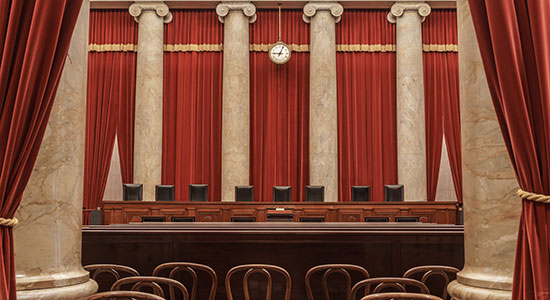
Day 1: ‘Equal Justice Under Law’
Hello, readers of the new Sua Sponte blog. I am blogging from Washington, D.C.
My husband (who is also my best friend and former colleague at the State Public Defender's appellate division) – is arguing a case before the U.S. Supreme Court. I don't think I could be more excited if it were my own case!
This morning I jogged around the Supreme Court's courthouse; and in a couple of days, I will be in that courthouse, watching some of the most brilliant legal minds in the country question my spouse about the Fourth Amendment.
EQUAL JUSTICE UNDER LAW. That's what it says across the front of the building. It seems obvious but for a couple of public defenders, who represent very unpopular people, it is deeply moving.
Day 2: Guidance for the Nervous
Arguing a case in the Supreme Court is nerve-wracking, so I was pleased to learn that the court provides counsel with a guide that contains much more than a brief explanation of timing.
It covers everything from how many attorneys can sit at counsel table, to how to begin your argument (“Mr. Chief Justice, and may it please the Court...”), to a caution against using humor.
I was also pleased to learn that the Supreme Court recommends that attorneys read (among other books) my personal favorite book: Making Your Case, The Art of Persuading Judges, by Justice Antonin Scalia & Bryan Garner.
It's a short, practical guide, and I still like to re-read it occasionally before oral arguments. The book offers guiding principles that are good reminders, such as:
be flexible (Principle #65);
stand erect and make eye contact with the court (Principle #76); and
present your argument as truth, not as your opinion (Principle #95).
An attorney preparing for argument in the U.S. Supreme Court also has to consider what colleagues and other spectators need to do to watch the argument. The Supreme Court is of course our nation's highest court, but it is also a major tourist attraction here in D.C.
There is a public queue (often quite long), a Supreme Court Bar queue (much shorter, but it can also be long), and a very limited number of reserved seats for each party.
The people who work for the Supreme Court Marshal's office are incredibly helpful with questions about all this, and I'm confident that all the “’Sconnies” who have come to D.C. to watch tomorrow afternoon's argument will get the opportunity.
Day 3: The Argument, and Where to Find a Supreme Court Travel Mug
The U.S. Supreme Court argument took place yesterday. After so many months of briefing and preparing for this day, the hour-long argument flew by.
There is a lot of pageantry involved with the Supreme Court. But once a case is called, it is a working court, with sharp jurists asking probing questions. A spectator (at least one who is an appellate attorney) can ignore the pageantry and get lost in the arguments. Each justice spoke yesterday except for Justice Clarence Thomas, and their questions were sharp and engaging.
My take is that the opinion could go either way.
(It is rumored that two members of Wisconsin’s highest court were also in attendance yesterday, although I didn’t see them. I would love to know what they thought but, alas, I don’t think they’ll be blogging about it.)
Here are some insider tips about visiting the court:
If you are a member of the Supreme Court Bar, the seating is excellent – very close to the bench.
The general public gets a good view, too, since the room is relatively small. If you are familiar with the Milwaukee federal courthouse’s ceremonial courtroom where Hon. Lynn Adelman presides, it’s around the size – although arranged quite differently.
Even a not-particularly-well-known case gets a lot of spectators, so it is important to get in line for an argument very early.
The court has a nice gift shop with unusual Supreme Court-branded items (Supreme Court sippy cup, anyone?), and a decent cafeteria.
I am a partisan for the appellant – but I must say that both advocates did a great job yesterday on the case. They both ably represented the State Bar of Wisconsin and the Appellate Practice Section – you can read about the argument on the SCOTUSblog.
So, congratulations to Assistant State Public Defender Andrew Hinkel and Assistant Attorney General Hannah Jurss!
